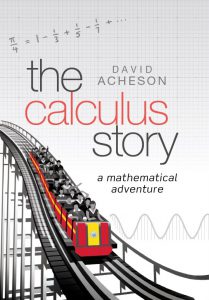The Calculus Story is the latest new book from author and mathematician David Acheson, telling the story of the history of calculus – with all the positive determinants and negative determinants along the way. The book came out on 23rd November through Oxford University Press. We spoke to David to find out what inspired him to tell the greatest (local maximum) story ever told.
 What’s The Calculus Story all about?
What’s The Calculus Story all about?
It’s an introduction to calculus for an unusually wide readership, mainly through the story of how the subject developed. And this turns out to be something of an adventure, largely because of the way infinity comes in at almost every twist and turn.
How is the book different to previous ones you’ve written?
My previous book, 1089 and All That, was a fairly light-hearted look at maths in general, and became something of a bestseller, with 11 foreign translations. The new book takes the subject a bit further, and is, if anything, even more ambitious, because it tries to explain not only what calculus is, but how to actually start doing it.
Calculus is all about the rate at which things change, and this is how we often get to understand, through the laws of physics, how the world really works. But the subject contains many results, too, that can be enjoyed purely for their own sake, usually because they are surprising in some way.
What do you hope the book will achieve?
It is always easier to embark on calculus if you have some idea from the very beginning of the subject as a whole – some ‘big picture’, if you like. Without that, you can easily get bogged down in comparatively minor detail, lose direction, and – even worse – lose interest.
My main hope, then, is that The Calculus Story provides that big picture, and in an unusually readable way.
And if anyone were to read the book as preparation for a university or college course, they would – in my view – really hit the ground running.
 Why did you choose to write the book now?
Why did you choose to write the book now?
I didn’t. The book has been gently brewing, in a way, since 1962, when I first met calculus, at the age of 16. For once you’ve met it, your mathematical life is never quite the same again – calculus just opens so many new doors.
What’s the most interesting fact you learned while writing the book?
If you drill a hole of given depth straight through the centre of a sphere, the amount of material left over is independent of the radius of the sphere!
Have you ever used calculus in ‘everyday life’?
No. Calculus underpins much of modern life, but in a rather hidden way, through the laws of physics, chemistry, biology and economics. It tends to be ‘under the bonnet’, so to speak.
The most likely way that calculus might be used explicitly in a truly ‘everyday’ context is to solve some optimisation problem.
Who do you think the book would best suit as a Christmas present?
You’d better ask the New Scientist. They have just selected it as one of their choices for Christmas, claiming that (a) it will fit in a stocking and (b) it has ‘something for everyone’!
More information
The Calculus Story, on Oxford University Press
The Calculus Story, on Amazon